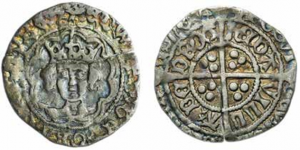THE SIMPSON COLLECTION OF HIBERNO-NORSE AND IRISH COINAGE
Spink London, 2nd April 2025
The Spink London Coin Department was delighted to return to the rostrum on 2nd April to present The John Noel Simpson Collection of Hiberno-Norse and Irish Coinage. Following the success of the collection’s banknotes in our NYINC programme in January, similar interest was exhibited for this extensive collection of Irish numismatics.

Penny, Dublin
The collection was compiled from the 1980s onwards by keen collector and former chairman of the Numismatic Society of Ireland (Northern Division), John Noel Simpson (b.1934), known to many as Noel. Ranging from Hiberno-Norse pennies, Irish Civil War ‘Gunmoney’, through to key date pieces of the 20th century, it is certainly the most comprehensive assemblage of Irish coinage to be offered in these rooms since the Lucien Lariviere Collection in 2006.
The selection of Hiberno-Norse pennies alone rivals the celebrated S.N. Lane collection sold by Spink in September 1982. Records reveal that this important collection did not escape the interest of Simpson, with him making several purchases from the sale (offered as Lots 1, 3, 11 and 15). A particular highlight was undoubtedly Lot 13, an extremely rare Phase II/III mule Penny of Dublin. Struck during a time of coinage reform, this scarce survivor is believed to be one of only three known examples. Struck on good metal and with a pleasing portrait, it clearly shows the muling of the earlier ‘E’ symbol portrait types with that of the latter reverse ‘hands’ type.

“it is certainly the most comprehensive assemblage of Irish coinage to be offered in these rooms since the Lucien Lariviere Collection in 2006.”
The medieval portion of the collection also afforded collectors the opportunity to acquire some truly sought-after rarities. Notably, collectors of Drogheda mint were well catered for by the inclusion of an Edward IV, Light “Cross and Pellets” Coinage, Halfgroat (Lot 83). This richly cabinet-toned specimen is the third known example and only the second in private hands. The other privately owned specimen was previously sold by Spink for £3,600 in 2010, while the other is housed in the National Museum of Ireland collection. The short reign of Richard III was well represented by another specimen from Drogheda, a Suns & Roses Coinage, Groat of 1483 (Lot 98) and a Three Crowns Coinage, Groat of Waterford (Lot 100). Both excessively rare and due to their infrequent appearance on the open market, these pieces most definitely proved to be a significant draw.

The collection covers a broad range of Tudor and Jacobean material before reaching the reign of Charles I. The highlight piece of this section was the O’Neill Money Crown of 1646 (Lot 168). Traditionally referred to as ‘Rebel Money’, this piece is believed to have been struck under the instruction of Eoghan Ruadh Ua Néill (Owen Roe O’Neill) in the aftermath of the battle of Benburb, Tyrone, July 1646, in which Ua Néill led the Army of Ulster to victory. Prior to the battle, Ua Néill received £10,000 in silver from the Vatican Papal Nuncio to Ireland, Giovanni Battista Rinuccini. It is this silver which is believed to have been translated into this coinage, for Ua Néill to pay his army. The obverse design of the coin, which shows a cross potent in a circle, is also of great significance. Not only does it refer to the battle flag of the confederate Catholics, it harks back to the ancient symbol of Irish Christianity, as evidenced by the existence of the Kilnasaggart stone in Armagh.

Collectors of ‘Gunmoney’ were delighted to see a spectacular array of over 100 pieces ranging from crowns to sixpences. Every effort had been made by Simpson to collect a broad range of dates and varieties as categorised by Withers. Highlights include a number of error dates, such as a large ‘9r’ Shilling of November 1689 (Lot 238). One of the greatest scarcities of the series, this specimen in strict very fine condition, is unique within the series due to the inclusion of a castle below the laureated portrait of James II. Other error varieties include the ‘Jnue’ Halfcrown of 1690, a small selection of ‘8BER’ pieces and a ‘RIX’ Crown of 1690. Simpson’s interest also extended to off-metal issues, hence the inclusion of a Proof Silver small Shilling of May 1690 (Lot 245). This enchanting piece in good very fine condition has a most pleasing portrait upon residually flashy fields. With only eleven examples known to Withers, this piece is a fantastic addition to any cabinet.

Simpson’s interest in all branches of Irish coinage extends to include a fantastic selection of proof pennies and halfpennies of the Georgian era. The unrivalled highlight is Mossop’s “Unfinished” Proof Pattern “Union” Penny of 1789, struck in “yellow” copper (Lot 289).
William Mossop, a “letter-cutter and die-sinker” of Dublin, prepared this pattern in recognition of the Union of England and Ireland. Only six examples are believed to have been struck from the finished dies before they fractured. Rarer still, this incomplete specimen is supposedly one of only two and is understood to be one of Mossop’s own initial strikings. The other known example has been housed in the Ulster Museum since 1970, making this piece the only privately owned example. This extremely fine specimen, with a handsome uniform patina, which would have been present when in the ownership of Mossop, has a pedigree dating to its purchase by Dr Archibald Nadauld Brushfield from Glendining in December 1910. In addition to the esteemed Brushfield name, this pattern has also been owned by Albert Edward Bagnall, Harry Alexander Parsons, Jess Peters, Munro and Norman Applebaum, before arriving in the hands of Simpson.
The John Noel Simpson Collection of Englsh, Irish and Hiberno-Norse Coins was offered for sale in London on 2nd April 2025. For further details and sale results please contact Georgie Potter, [email protected].
